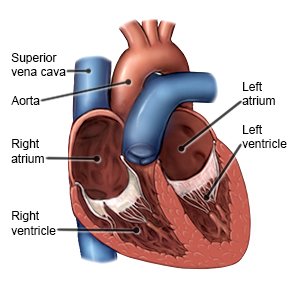Prevent Endocarditis in your Child
Medically reviewed by Drugs.com. Last updated on Aug 4, 2025.
AMBULATORY CARE:
Endocarditis
is an infection of the inner lining of your child's heart. Endocarditis is most often caused by a bacterial infection. It may also be caused by viral, fungal, or parasitic infections.
 |
Your child may be at risk for endocarditis if he or she has any of the following:
- A history of endocarditis
- Congenital heart disease
- Damage to the heart valve from infection or injury
- An artificial heart valve
- A heart surgery or procedure
- Use of medicine that weakens the immune system such as steroids
- A condition that weakens the immune system such as HIV or lupus
- A urinary or IV catheter
- Implanted devices in the heart such as a pacemaker or defibrillator
Call your local emergency number (911 in the US) if:
- Your child has trouble breathing.
- Your child loses consciousness or cannot be woken.
Seek care immediately if:
- Your child has a fever and chills.
- Your child has a cough or shortness of breath.
- Your child has a headache, body aches, or joint pain.
- Your child has a fast or pounding heartbeat.
- Your child has swelling in his or her legs, feet, or ankles.
- Your child has chest or abdominal pain.
- Your child has red or purple dots on his or her hands or feet.
Call your child's doctor if:
- Your child will not eat or has a poor appetite.
- Your child is very weak.
- You have questions or concerns about your child's condition or care.
Keep your child's teeth and gums healthy:
Bacteria can enter your child's blood through cavities or sores on their gums. The bacteria may travel to their heart and cause endocarditis. Do the following to help prevent cavities and gum sores:
- Help your child clean their teeth and gums.
- Before your child's teeth come in, clean his or her gums and mouth with a soft cloth or infant toothbrush once a day.
- Begin to brush your child's tooth as soon as you see one come in. If your child is younger than 3, brush his or her teeth with a children's toothbrush and a smear of fluoride toothpaste. The smear should be the size of a grain of rice. Make sure your child spits out all of the toothpaste. Do this twice a day.
- If your child is older than 3, brush his or her teeth twice a day. Apply a pea-sized amount of fluoride toothpaste to the toothbrush. Help them floss once a day. Have your child brush their teeth for at least 2 minutes. You may need to help your child brush and floss their teeth until they are 7 or 8. Make sure your child spits all of the toothpaste out. Your child does not need to rinse his or her mouth with water. The small amount of toothpaste that stays in the mouth can help prevent cavities.
- Take your child to the dentist. Your child should start seeing a dentist at 1 year of age. Your child's healthcare provider may recommend that he or she see a dentist within 6 months after their first tooth comes in. After 1 year of age, your child should go to the dentist for a checkup every 6 months.
- Put only formula or breast milk in your baby's bottle. Do not put sweetened drinks, such as juice, in his or her bottle. Limit juice intake to 6 ounces per day.
- Feed your child healthy foods and drinks. Choose foods and drinks that are low in sugar. Read food labels to help you choose foods that are low in sugar. Limit candy, cookies, and soda.
Ask your child's doctor if he or she should take antibiotics before procedures:
Some procedures may cause bacteria to get into your child's blood and travel to the heart. Examples include certain dental procedures, and surgery to remove the tonsils.
Carry a wallet card that says your child is at risk for endocarditis:
This card will alert healthcare providers that your child is at risk for endocarditis. It will also help them decide if he or she needs antibiotics before a procedure or in an emergency. You can get this card through the American Heart Association.
- American Heart Association
7272 Greenville Avenue
Dallas , TX 75231-4596
Phone: 1- 800 - 242-8721
Web Address: http://www.heart.org
Follow up with your child's doctor as directed:
Write down your questions so you remember to ask them during your child's visits.
© Copyright Merative 2025 Information is for End User's use only and may not be sold, redistributed or otherwise used for commercial purposes.
The above information is an educational aid only. It is not intended as medical advice for individual conditions or treatments. Talk to your doctor, nurse or pharmacist before following any medical regimen to see if it is safe and effective for you.
Learn more about Prevent Endocarditis in your Child
Treatment options
Care guides
Further information
Always consult your healthcare provider to ensure the information displayed on this page applies to your personal circumstances.
